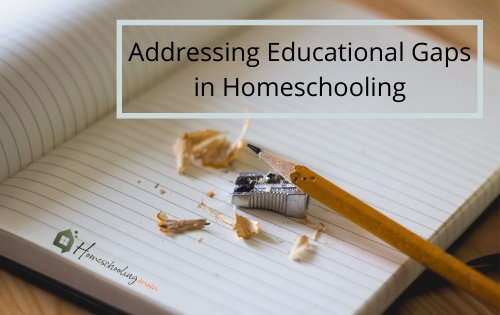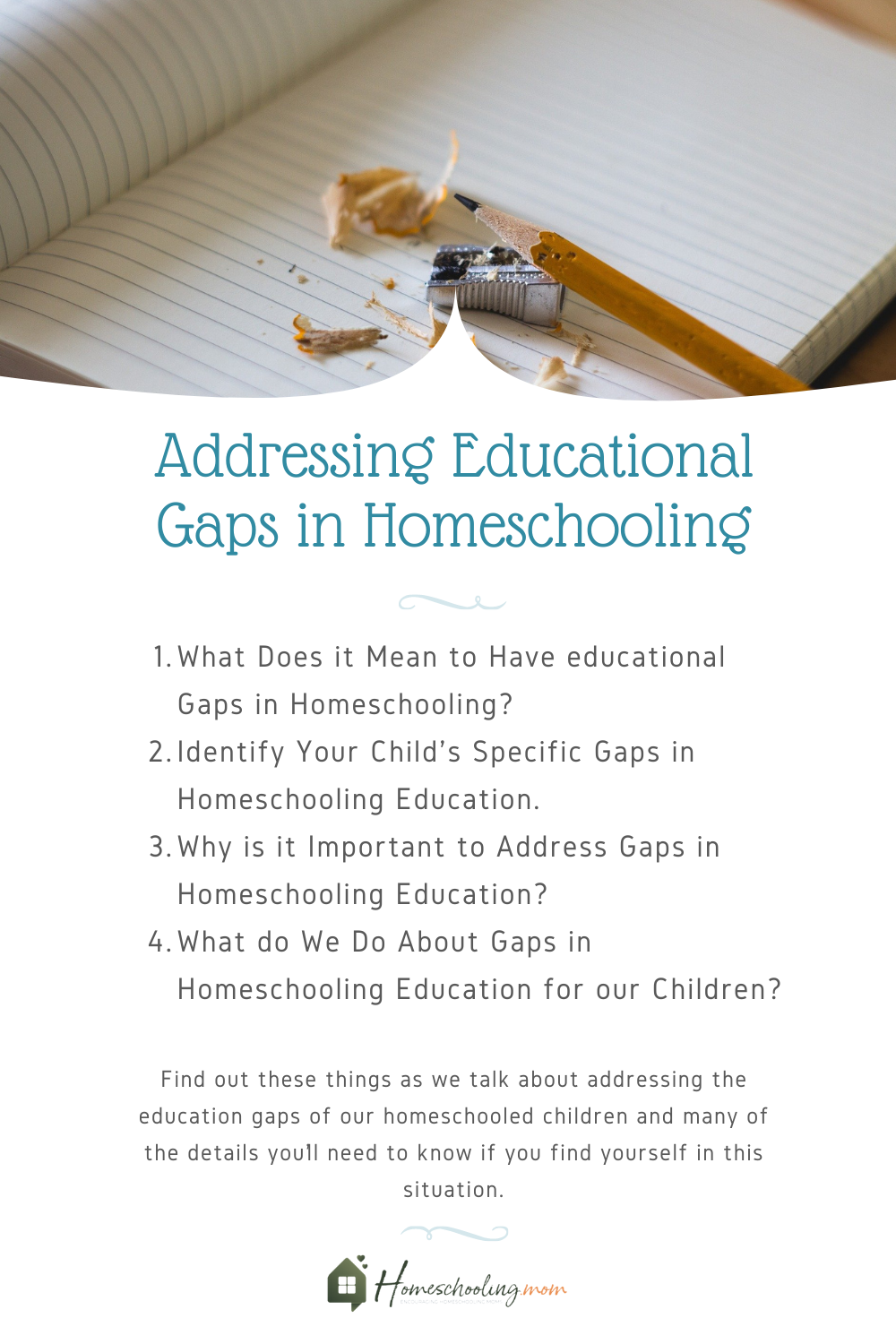Addressing Educational Gaps In Homeschooling
One of the most common reasons to address educational gaps in homeschooling is that you have pulled your child out of the public school system after a certain amount of time. Of course, educational gaps can also happen while homeschooling solely, also. In either situation, gaps in education must be addressed as soon as they are realized. If we are keeping adequate track of grades, progress reports, and the forward momentum of our children in their educational journey, it should be easy to catch them.
We’re going to talk today about addressing the education gaps of our homeschooled children and many of the details you’ll need to know if you find yourself in this situation. Sometimes it just happens and there’s no reason to panic. It’s important to know that we can catch up and keep moving forward, sometimes surpassing everything we imagined possible when it’s all said and done.

What Does it Mean to Have Gaps in Homeschooling Education?
Simply stated, if a child should know a certain thing by a certain age or grade level, but they don’t, that is an education gap. For instance, if they don’t know their multiplication tables by the fourth grade or are struggling with understanding the sounds that letters make in early elementary, which is then inhibiting their reading abilities, that is an educational gap.
And gaps in education are not what we homeschooling moms use to rate our children against same-age peers in public school. If their cousin, who is in public school, has learned a certain number of random facts in any given subject, but you haven’t taught those same facts to your child, who is the same age, then you can’t really label that an educational gap. This happens across state lines all the time. Some states require that their own state history be taught during a certain grade level. Does that mean that a child in a different state who doesn’t know that state history has an education gap? I think not. And the same can be said for your own child.
As we get started here, a word of caution: do not get caught in the comparison game while evaluating for educational gaps!
Identify Your Child’s Specific Gaps in Homeschooling Education
It’s pretty easy to see when our kids simply “don’t get it” when we teach certain things. It’s often described as a brick wall that we, as the homeschool mom, can’t seem to get around. Of course, we can’t expect our children to be able to know exactly what it is that’s causing the problem, so we must be the ones to take matters into our own hands and find a creative way to identify the problem.
It’s not always easy! Some homeschool parents choose testing, quizzes, or simply allowing their child to talk through certain aspects of what they know. How far they can get before running into that brick wall can often show us the problem to begin to address it.
Another way to look deeper into the problem is to go back to former lessons to see where the problem stops happening. Once you find this area, then you can almost guarantee that the problems started in the lessons that follow it. Or, in a very similar fashion, you can go back to the very foundational building blocks of the concept, especially in math or spelling, and quickly work through two or three problems per lesson until it starts to get “hard” for your child to work or answer those problems. I’ve actually done this myself while homeschooling my daughter. In the ninth-grade year, we went all the way back to elementary school math and worked forward until I found the specific gap we were looking for.
Why is it Important to Address Gaps in Homeschooling Education?
The simple answer to this question is that if we don’t address them, future learning will be harder and more cumbersome if it even happens at all. In cases where math gaps are allowed to go unattended, let’s say multiplication tables, for example, your child will never really be able to fully grasp other higher forms of math later in their school years. Algebra will be hampered, as will everything that comes after it. Going back to learn the information that was originally left unlearned, to begin with, is the only way to combat this situation. And it’s better done earlier than later.
The same is true in reading, comprehension, and other aspects of language arts. When letter sounds are not fully taught and comprehended by your homeschooler, higher learning cannot be built on top of these situations. It’s like trying to build a house upon the sand, which Jesus taught about:
And every one that heareth these sayings of mine, and doeth them not, shall be likened unto a foolish man, which built his house upon the sand: And the rain descended, and the floods came, and the winds blew, and beat upon that house, and it fell: and great was the fall of it. (Matthew 7:26-27)
We are the builders and our child’s education is the house. If we continue without addressing those educational gaps, at some point, that education will fall.
What Do We Do About Gaps in Homeschooling Education for Our Children?
Once you’ve evaluated for educational gaps and found legitimate areas that need your attention, the only thing homeschool families can really do is to take the homeschool student back and re-learn everything that should have filled that gap. Whether it’s math, or reading, or life skills, or something else that the next portions of their education will build on, we must take the time to go back and teach that information over again.
Some homeschool families address this problem by spending the first month of the new homeschooling year or however long is needed, to seal up those gaps. A good curriculum choice, focusing on your child’s learning style, and complementing it with an appropriate homeschool teaching style are all great ways to make sure your child has the best opportunity to relearn the information and move on.
If you work on a year-round homeschooling calendar, you might even choose to let “summer school” stand as the period in which you work on filling those gaps in education. With creative processes and interweaving games and activities into learning, you can fill the gaps quicker than you think. Don’t be afraid to use educational media, apps, games, and other fun activities that can make learning more appealing to your child and thus, easier to teach.
Whatever you do, do not continue to push forward forcefully when it’s obvious your child is struggling! To do so will not only make the educational gap more pronounced and hurtful, it can strip away that love of learning that we fight so hard to instill in them through all our efforts.
What’s more, you don’t have to wait or plan or set aside time to do this. You can address educational gaps starting today! Right where you are! Even in small increments, addressing the educational gaps as soon as you know what they are is the very best way of assuring eventual success. Yes, you can always dive deeper at some point in the future, but there is no time like the present.

In Closing
Choosing to address gaps in homeschooling education is one of the joys of home education that we give our kids. The freedom to teach them and help them grow and succeed is something I’m sure we’re all thankful for. So naturally, when we find educational gaps, it should never be a condemnation of ourselves. Our kids are their own individual little people and, as such, they’ll have certain things they struggle with.
The important thing is that we calmly press through situations like these, working methodically in ways that will provide a solution, and not in a panic, which results in chaos. With just a bit of focus, research, and application, we can find, evaluate, and close these educational gaps, all through the homeschooling journey that we’re on.









Stacey Wells
Stacey is an author, blogger, and former homeschool mother who loves to encourage and uplift, especially on the subjects of faith and homeschooling. She lives in Central Kentucky with her husband, Jimmy, and their two children. For more information, visit her website, Words From The Wheel.